Physical Address
304 North Cardinal St.
Dorchester Center, MA 02124
Inflicted physical abuse to children is a grotesque act that no one likes to diagnose. This phenomenon accounts for nearly 20% of all child maltreatment cases, which encompass a spectrum of offenses including neglect, sexual and physical abuse, and psychological maltreatment. Many terms have been used to describe the orthopedic manifestations of physical abuse and include battered child syndrome, nonaccidental trauma, and the current convention of child physical abuse (CPA).
Unlike many chapters in this book in which technologic advances have changed the care of children’s fractures, such advances are unlikely to help treat child abuse. Instead, this chapter will provide the basis for greater education, training, and awareness that will enable physicians to better recognize child abuse, reduce missed diagnoses, and aid in the reporting of CPA. The topic remains in the forefront of the American Academy of Orthopaedic Surgeons (AAOS), Pediatric Orthopaedic Society of North America, and pediatric orthopedic thought leaders who continue to update diagnostic workup indications for femur fractures. These changes have been included in the most recent clinical practice guidelines by the AAOS in an effort of continued education in identifying at-risk patients.
In 1961, the Children’s Bureau of the US Department of Health, Education, and Welfare published a model law that required mandatory reporting by physicians and other medical professionals. Although the exact reading of the law in various communities may differ, all statutes require prompt identification of any suspected case of abuse. Typically, physicians are granted immunity from civil and criminal liability if a report is made in good faith.
Maliciously reporting abuse when it is not the cause of injury, however, may expose an individual to the risk of litigation. Unfortunately, the litigious environment in which we live has given concomitant rise to the number of lawsuits from parents who feel they have been falsely accused. This risk of litigation leads to healthcare providers’ reluctance to become involved in child protective matters, which is a trend that must be avoided. Conversely, civil suits have been filed against physicians for failure to report acts of child abuse, and most laws impose a criminal penalty for failure to report suspected child abuse. Fortunately, the trend in most parts of the world is that of increasing recognition of the phenomenon and improved healthcare education about it. Heightened awareness should improve legal protection for reporting healthcare providers.
Although the radiographic findings of child abuse have been known for more than a century, it was not until 1946 that Caffey studied six children with chronic subdural hematomas and fractures of long bones with no history of injury. He stated that they did not have a systemic disease that could explain the radiographic findings and believed that injury to the children was responsible for the findings. He further suggested that children with unexplained long bone fractures should be investigated for chronic subdural hematomas and vice versa.
In 1953, Silverman described periosteal new bone formation associated with irregular fragmentation of the metaphyses in children and believed that this injury was part of the syndrome that Caffey originally described. In 1960, Altman and Smith reported cases of unrecognized trauma in children, and in 1972, Kempe and Helfer coined the term battered child syndrome.
Reporting continues to increase, demonstrating a nearly 15% rise from 2012 to 2016. Unfortunately, fatalities have continued to rise despite an overall decrease in physical abuse previously reported.
This chapter will focus on the orthopedist’s role in the care of children who are victims of CPA and their assistance with injury evaluation and management in physical abuse. However, the treating surgeon must be familiar with other forms of child maltreatment. Recognition of the signs of neglect, sexual abuse, or emotional maltreatment may lead the treating physician to consider child abuse as a possibility.
Child neglect has been defined as “an omission in care by caregivers that results in significant harm or the risk of significant harm.” Neglect, accounting for 75% of all child maltreatment, is the most common form of child maltreatment and includes categories such as physical, medical, supervisional, educational, and emotional. Neglect can be acute or chronic and may be quantified by the severity, frequency, and chronicity of the caregiver’s omissions. Physical signs of neglect include malnutrition, pica, constant fatigue and listlessness, poor hygiene, and inadequate clothing for the circumstances. Behavioral signs of physical neglect include lack of appropriate adult supervision and even “role reversal,” in which the child becomes the parental caretaker. Other signs include drug or alcohol abuse, poor school attendance, and exploitation by the parents, such as being forced to beg or steal. Importantly, although the rates of physical and sexual abuse have been decreasing over the past 3 decades, child neglect remains stubbornly unchanged.
Unfortunately, when one form of child maltreatment has been identified (e.g., neglect), it is not uncommon for additional types to be present (e.g., physical abuse). The presence of multiple types may have a negative synergistic effect on the child’s physical and mental well-being, as the worst outcomes associated with child maltreatment include the comorbidities of physical neglect, emotional neglect, verbal abuse, and physical abuse.
Child sexual abuse has been defined as “. . . the involvement of dependent, developmentally immature children and adolescents in sexual activities that they do not fully comprehend, to which they are unable to give informed consent, or that violate the social taboos of family roles.” Child sexual abuse encompasses both contact abuse (e.g., genital, oral, anal, or fondling) and noncontact sexual exploitation of a minor (e.g., child pornography). Most orthopedists are poorly trained in the evaluation of sexual abuse. Fortunately, the American Academy of Pediatrics and its Committee on Child Abuse and Neglect summarize the epidemiology of child sexual abuse, appropriate care of child victims, and the physical and emotional consequences. They have developed specific protocols for the evaluation of sexual abuse, for which there is now specialty certification.
Sexual exploitation is usually perpetrated by someone known to the child and may continue over a prolonged period. A description of the physical signs of sexual abuse is beyond the scope of this text; however, the behavioral signs should be recognized because their presence may alert the physician that the child is a victim of sexual abuse. A child who is a victim of sexual abuse may demonstrate internalizing behaviors (i.e., withdrawn, depressed) or externalizing behaviors (anxiety, emotional outbursts, aggressiveness), engage in sexually reactive behaviors, develop eating disorders, and/or develop substance abuse problems. These children may also become sexually promiscuous and may sexually abuse a sibling.
Although soft tissue injuries are the most common finding in child abuse, 10% to 70% of physically abused children manifest some form of skeletal trauma. It is estimated that 30% to 50% of physically abused children are seen by orthopedists for fractures or other orthopedic problems. An orthopedist caring for injured children must be familiar with abuse-related injuries and the clinical manifestations of such injuries to appropriately diagnose and intervene in suspicious cases.
Recognition of physical abuse is extremely important in protecting the involved child, in addition to other children living in the home. Approximately 9% to 12% of child household contacts or siblings of the abuse victims will have a history or injuries consistent with abuse. Of children returned to an abusive home without intervention, 35% to 50% will be abused again, and the second incident may be fatal in 5% to 10%. Early identification and intervention in cases of child abuse cannot be overemphasized, and the results are encouraging for reducing rates of future CPA among abusive parents. The effectiveness of programs varies depending on the type of intervention, with parent-child interaction therapy seemingly most promising.
The younger the child, the more vulnerable he or she is to maltreatment. In 2016, an astounding 29% of all cases of CPA occurred in children younger than 3 years of age. Furthermore, 50% of fractures in children younger than 1 year of age are attributable to abuse. These figures alone are just cause for thorough workup in young children, particularly infants, who are seen with fractures. Multiple reports further substantiate these findings. Victims of CPA seen in the emergency department have similar age demographics. In fact, 10% of the total trauma population younger than 3 years is nonaccidental, as are 30% of head and limb injuries in this age group. Highest rates of child maltreatment fatalities occur in the youngest age group: nearly 80% of the deaths occur in children younger than 3 years and more than 40% in children younger than 1 year. Even though only 58% of the children in the study by Herndon were younger than 3 years, they accounted for 94% of the fractures. A pattern of decreasing incidence of nonaccidental fractures with increasing age corresponds to the increasing incidence of accidental fractures with increasing age up to 12 years. In fact, children older than 5 years account for less than 10% of the fractures related to abuse.
Historical clues remain one of the most important tools in diagnosing child abuse. Additionally, tools have been created to help investigate CPA. One such tool is the injury plausibility method, which helps tabulate historical data into the likelihood of injury from falling from stairs, a common occurrence yet also a common false explanation excuse for child abuse. Differentiating CPA from unintentional injuries has also been described in a Likert-like fashion, with the use of criteria to determine the likelihood of abuse within a spectrum of “definitely not inflicted injury” to “definite inflicted injury.” This highlights the fact that diagnosing CPA often requires clinical judgement. Although many of the skeletal findings associated with CPA are highly specific, there is no single injury that, in and of itself, is diagnostic.
Various societies and professional organizations have developed practice guidelines for interviewing in cases of alleged child abuse. These guidelines detail the purpose of the forensic investigative interview, background and procedures of the interviewers, the context and content of the interview, and special issues for law enforcement investigators. Orthopedists should be aware of guidelines so that the information obtained will be useful to those who must later make difficult decisions regarding the placement of children back in the home of the involved patients.
Orthopedists must be cognizant that numerous disciplines have trained specialists who are competent in performing specialized interviews, including law enforcement personnel, child protection services personnel, members of the district attorney’s office (e.g., assistant district attorneys), and child forensic interviewers (e.g., social workers, psychologists, or physicians), and who are members of specialized child assessment teams. If available, children should be referred to specialty clinics (i.e., child advocacy centers) for evaluation. It is vital that people with appropriate training in this interview method be allowed to conduct a proper interview in a timely manner.
Recommendations intended to improve the quality of the information obtained include these:
Children should undergo an interview as soon as possible after the initial disclosure of the abuse.
The child should be separated from the parent, if possible, for the interview, to prevent undue influence (intentional or unintentional).
If not previously established, the interviewer should develop a rapport with the child by initially asking about nonthreatening issues.
The interviewer should not ask leading or suggestive questions. The interviewer should begin with open-ended questions to encourage a narrative response and then transition into more direct questions, if necessary.
Questions should be asked with the use of developmentally appropriate language. A description of the abuse should be recorded word for word, with the use of quotation marks.
The interviewer should not urge or coerce the child to talk about the abuse, should be supportive and show respect toward the patient, and should avoid appearing shocked or upset if/when the patient describes the abuse.
The orthopedist’s role is to treat the child’s injuries while carefully documenting the child’s and caregiver’s provided history in a nurturing manner. The facts gathered and documented are important in helping investigative agencies that will eventually compare stories and corroborate facts. The parent or caregiver’s account of the injury can be vague and incomplete; he or she may be evasive or contradictory or fail to volunteer details regarding the incident. The degree of physical injury may be inconsistent with the history given, and often the reported time of injury does not correlate with the obvious age of the injury. A delay in seeking treatment is suspicious. A history of repeated trauma in which the child has been treated at several different facilities should arouse suspicion.
The parents’ response to the situation may be inappropriate. They may be critical of or angry with the child for being injured, or they may ignore the child completely. Other parents may become overly involved.
The social history will provide additional information in identifying children at risk. Children with birth defects and families with disabled children are at higher risk of child abuse in the home. Socially isolated families with no external support system tend to be more abusive. Abuse is also more common in families in which the parents are involved in a violent interpersonal relationship. Adults who were childhood victims of abuse are more likely to become abusive parents, as are those with unrealistic expectations for their children (i.e., expectations inconsistent with the child’s developmental or intellectual abilities). Families with increased stress are vulnerable. Drug or alcohol abuse increases the likelihood of abuse. Mental illness of caregivers is also a significant risk factor for child maltreatment.
Any condition that interferes with normal parent-child bonding and results in lack of normal parental contact increases the risk of child abuse. Irritable or hyperactive children or children with physical or developmental disabilities are more likely to suffer abuse from their parents or caretakers. Premature or low-birth-weight infants, who may require more care and attention, are abused three times as often as full-term infants. In a report reviewing infant homicide, a mother younger than 17 years of age, a second or subsequent birth in a mother 19 years or younger, no prenatal care, and a low level of education were cited as the strongest risk factors. Because infanticide occurs most often in the first few months of life, intervention during pregnancy and the postpartum period is recommended.
An orthopedist caring for children’s fractures will probably be confronted with children who have sustained musculoskeletal injuries as a result of abuse. The possibility of CPA must always be considered, and a complete and systematic examination of the child must be performed.
Important general considerations for physical examination findings that should raise concern for CPA include:
any injury to a young, preambulatory infant, including bruises, mouth injuries, fractures, and intracranial or abdominal injury;
injuries to multiple organ systems;
multiple injuries in different stages of healing;
patterned injuries; for example, blunt instrument marks or burns, circumferential immersion burns, human hand or bite marks;
injuries to nonbony or other unusual locations, such as over the torso, ears, face, neck, or upper arms;
significant injuries that are unexplained; and
additional evidence of child neglect.
Careful documentation of skin and soft tissue injuries is required, including the size, shape, location, and estimated stage of healing of any lesions. The entire axial and appendicular skeleton is then examined. The injured area is examined last to lessen the child’s anxiety. Whereas tenderness, crepitus, or instability may be present in acute fractures, palpable callus without associated tenderness may be noted in healing fractures. Any of the aforementioned findings warrant radiographic examination.
Soft tissue injuries may include bruises or welts over any part of the body. Areas particularly subject to trauma are the face, head, and neck, including the lips, mouth, ears, and eyes. Bruises about the trunk, back, buttocks, and thighs are also common. Bruises may form regular patterns resembling the shape of the object that was used to inflict the injury, such as a hand, fist, belt or belt buckle, or electric cord. A common mnemonic for suspicious bruises is “TEN-4” : which stands for:
T: torso;
E: ear;
N: neck;
4: in children less than 4 years of age and any bruise in an infant under 4 months of age.
Multiple body surface involvement or multiple injuries in various stages of resolution suggest abuse and warrant further investigation.
Burns are also commonly seen and may be noted in conjunction with other injuries. Cigarette burns may be present, especially on the palms, soles, back, or buttocks. Immersion burns form a regular pattern. If the child is pushed into a tub or sink of very hot water, the burns will occur around the buttocks and genitalia. However, if one of the extremities is dipped in hot water, a stocking-glove distribution of the burn may be seen. Pattern burns may result if the child is burned with an instrument such as an iron, grill, or some other hot object with a recognizable shape.
Lacerations may occur anywhere on the body, including rope burns on the wrists, ankles, neck, or torso. Lacerations about the head and face are frequently noted and may even be seen inside the mouth or ears. One must also look for injuries to the genitalia and other body surfaces.
Injuries to the abdomen and to the components of the abdominal cavity may result from child abuse. Bruises of the abdominal wall and bleeding within the wall of the small intestine may be seen. Rupture of an abdominal viscus has been reported, including the intestine, spleen, liver, pancreas, and blood vessels. The kidneys, adrenal glands, and bladder may also be injured.
Trauma to the central nervous system is common and may be severe. Subdural hematomas in an abused infant may result from blunt trauma, violent shaking, or a combination of both. Hematoma is a frequent finding in abusive head trauma (historically known as shaken baby syndrome). Ophthalmologic examination will demonstrate the presence of retinal hemorrhage. The presentation of nonaccidental head injury is different from that seen in motor vehicle crashes. When seen, patients with inflicted head injuries are more often lucid and have higher Glasgow Coma Scale scores than those involved in motor vehicle accidents.
An abused child is likely to have behavioral characteristics that may be the result of physical or emotional abuse. Abused children may be less compliant and more negative and unhappy than the average child. Abused children may be hypervigilant and wary of any contact with adults. They tend to be angry, feel isolated, and show destructive behavior. They may be abusive toward others and have difficulty developing normal relationships. Parental separation is frequently difficult, but occasionally an abused child will be indifferent to separation from the parents. These children may constantly seek attention and may also show developmental delays.
In cases of suspected physical abuse, conventional skeletal radiography by way of a skeletal survey is the primary screening examination. This survey should consist of anteroposterior (AP) views of arms, forearms, thighs, and legs; posteroanterior views of hands and feet; frontal and lateral views of the thoracolumbar spine with adequate penetration for visualization of the ribs; AP views of the abdomen/lumbosacral spine/bony pelvis; lateral views of the lumbar spine; AP and lateral views of the cervical spine; and frontal and lateral views of the skull. The American College of Radiology (ACR) and the Section on Radiology of the American Academy of Pediatrics recommend that a high-quality radiographic skeletal survey (1) involve the use of a high-detail imaging system, with technical factors designed to optimize image contrast and spatial resolution; and (2) include the addition of Townes and right and left lateral views of the skull, at least two views of all areas suggestive of skeletal injuries during the initial survey that require orthopedic treatment, and additional oblique views of the thorax for rib fractures. Skull films may be foregone if the child is receiving a head computed tomography (CT) scan with three-dimensional reconstruction, as that modality is superior to plain films of the skull for identifying fractures. The “babygram” with the entire child on one radiograph has long been considered unacceptable and is likely to miss fractures.
The methods in which the plain films are obtained have rapidly changed over the past decade. Conventional film-screen imaging has historically been the method in which radiographs were obtained. However, computed radiography is rapidly becoming the standard. It was estimated by 2004 that nearly 80% of pediatric healthcare imaging facilities in the United States had migrated to digital technology, and this is likely higher currently. The advantages of this process are many; those that are applicable to diagnosis in CPA lie in the postprocessing abilities that are available. When used optimally, postprocessing improves the visualization of pathology while improving local contrast.
Recent discussion about radiation safety in the pediatric population indicates that clinicians need to be aware of the risks versus benefits of medical imaging studies. In suspected child abuse cases, the consequences of unrecognized inflicted trauma can be devastating. Jenny and Crawford-Jakubiak published a study describing 173 cases of abusive head trauma. Of the cases, 54 (31%) were misdiagnosed on initial presentation, and 19 of the 54 misdiagnosed children sustained additional injuries after the missed diagnosis, including 4 fatalities. Although the risks of radiation exposure are not necessarily negligible, they are relatively small compared with the expected benefit of timely recognition of physical abuse and protection from additional inflicted or fatal injuries.
Although CPA in children can present with nearly any injury pattern, some injuries observed in battered children are more characteristic of this population and are more likely to be the result of inflicted injury. These are skeletal injuries, including fractures of the ribs, metaphyses, and skull. The appropriate selection of radiographic imaging can facilitate detection of these injuries. In particular, detection of a metaphyseal fracture depends on high-quality, small field-of-view radiographs. Postimage processing allowed by computed radiography is helpful in improving the quality of films for this type of injury investigation. The injury appears as a radiographically lucent area within the subphyseal metaphysis, extending completely or partially across the metaphysis, roughly perpendicular to the long axis of the bone. Acute rib fractures in children younger than 2 years are highly suggestive of CPA. These fractures appear as linear lucent areas but are very difficult to visualize, and some suggest the sensitivity of plain films to be less than 50%. Thus, follow-up radiography increases detection of these fractures, and chest films on follow-up are warranted. For skull injuries, plain radiography is historically the gold standard. However, there is evidence that CT is superior for detecting fractures. Adopting this modality as standard protocol is controversial. However, in cases in which a high suspicion exists, CT should be used. CT and magnetic resonance imaging (MRI) best depict intracranial injury ( Fig. 20.1 ).
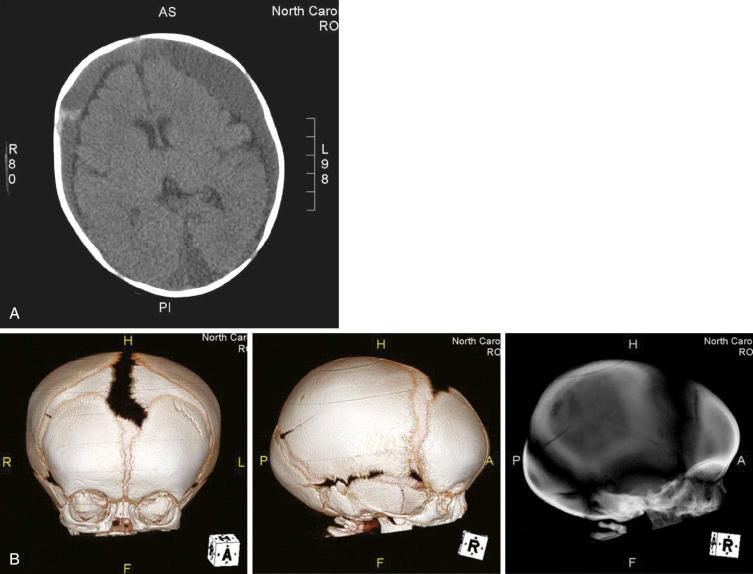
Follow-up skeletal surveys (approximately 2 weeks after the initial evaluation) have been shown to be helpful in identifying and dating skeletal injuries in cases of suspected child abuse. In one study reviewing 796 cases, additional information regarding skeletal injury was obtained in 21% of those cases. The use of bone scintigraphy is considered complementary, but not an alternative, to skeletal survey. It is sensitive for pelvis, rib, spine, acromion, and subtle diaphyseal trauma, but is considered inferior in the classic metaphyseal lesions. Unfortunately, an abnormal bone scan is not specific for trauma and may be seen in a variety of other conditions. In addition, interpretation of bone scans in children is often difficult, and even minor errors in positioning may simulate focal abnormality. The ACR considers this modality a “problem solving rather than a first-line study” in its ACR Appropriateness Criteria on suspected physical child abuse.
Historically, ultrasound and arthrography were considered for cartilage or joint injuries, and this continues to be the case for distal humeral epiphyseal separation in young children. For these injuries and an increasing number of other clinical indications, MRI is being used. However, MRI has a low sensitivity for classic metaphyseal lesions and rib fractures. It does have utility in identifying soft tissue abnormalities or in the differential diagnosis to rule out other causes of periosteal reaction, for example, osteomyelitis.
As indicated previously, CT scan of the head is the examination of choice for intracranial injury in child abuse. CT of the ribs can also be helpful. These areas are often difficult to assess for fractures with the use of plain film radiography. In difficult cases, platforms exist to assist with manipulation of digital images and volume renderings that can make the diagnosis clearer ( Fig. 20.2 ).
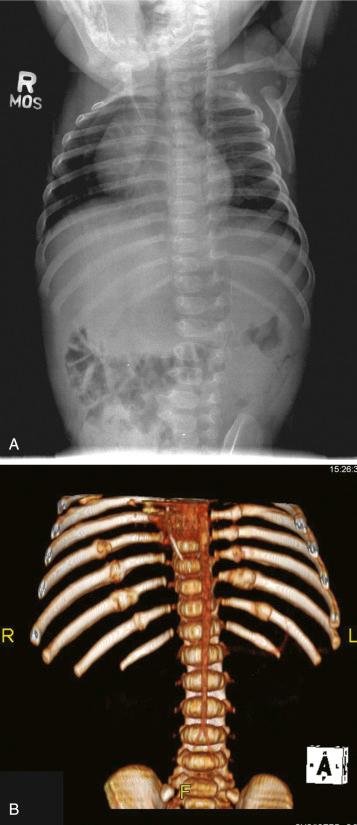
A basic knowledge of the stages of fracture healing that can be detected radiographically is imperative for orthopedists caring for injured children. A fracture in a radiographic stage of healing that does not correspond to the stated date of injury should arouse suspicion. Table 20.1 gives a general timetable for the various stages of fracture healing, and a brief outline is presented here. Very young infants may exhibit an accelerated rate of response, so the timetable should be considered only an estimate.
Resolution of Soft Tissues
Obliteration of the normal fat planes and muscle boundaries occurs as a result of hemorrhage and inflammation. These changes are the first and sometimes the only evidence of a fracture immediately after injury. Depending on the magnitude of injury, these changes may persist for several days.
Periosteal New Bone
Radiographically, periosteal new bone formation is not evident until it calcifies, usually between 7 and 14 days in an infant; however, it may occur in as few as 4 days. Continued subperiosteal hemorrhaging caused by repetitive trauma to a fracture that is not immobilized may result in extensive, or “exuberant,” fracture callus.
Loss of Fracture Line Definition
As necrotic bone is resorbed, the sharply defined margins of fresh fractures become blurred. The fracture gap appears to widen and becomes indistinct. It reaches a peak between 2 and 3 weeks but is not generally apparent before 1 week. Bucket-handle metaphyseal fractures or corner fractures can frequently be dated only by this method because periosteal new bone formation does not occur.
Hard Callus Order
Approximately 1 week after soft callus is visible, the fracture site is bridged by lamellar bone. This phase of healing is complete between 3 and 6 weeks.
Remodeling Order
Patient age, the degree of displacement, and the amount of callus formation are all variables involved in bone remodeling. A young child with a nondisplaced fracture may complete remodeling in a few months; however, an older child with a displaced or angulated fracture may continue remodeling for more than a year.
| Category | Early | Peak | Late |
|---|---|---|---|
| Resolution of soft tissues | 2–5 days | 4–10 days | 10–21 days |
| Periosteal new bone | 4–10 days | 10–14 days | 14–21 days |
| Loss of fracture line definition | 10–14 days | 14–21 days | — |
| Soft callus | 10–14 days | 14–21 days | — |
| Hard callus | 14–21 days | 21–42 days | 42–90 days |
| Remodeling | 3 months | 1 year | 2 years to epiphyseal closure |
Almost any bone can be fractured; the extremities, skull, and rib cage are the most common sites of injury. However, in one series, fractures of the long bones accounted for 68% of all fractures in patients who were the victims of child abuse. Although no fracture pattern is absolutely pathognomonic of physical abuse, certain fracture patterns have been found to be more characteristic of abuse than others. These patterns include metaphyseal or epiphyseal fractures (e.g., corner fractures, bucket-handle fractures, and chip fractures), posterior rib fractures, multiple or wide complex skull fractures, scapular and sternal fractures, multiple fractures, and unreported fractures. Single fractures, linear narrow parietal skull fractures, long bone shaft fractures, and clavicular fractures are all associated with child abuse but have low specificity. Whereas spiral fractures were the most common long bone fracture pattern reported by earlier authors, more recent data suggest that single, transverse long bone fractures are the most common fractures in child abuse. Because these fractures are also seen in accidental trauma, they are not specific for abuse.
It cannot be overemphasized that one of the most difficult problems in the diagnosis of abuse is the child seen with an isolated long bone fracture with unlikely history but no other stigmata of abuse. These fractures can be ubiquitous and are seen in every pattern: spiral, oblique, and transverse fractures. Equally difficult is that long bone shaft fractures may result from accidental or CPA ( Figs. 20.3 and 20.4 ). Transverse fractures are the result of direct injury, whereas spiral fractures result from rotational or torsional forces ( Fig. 20.5 ). An abusive parent may use either mechanism, so both fracture patterns may be seen in abuse. An isolated diaphyseal fracture is the most common fracture pattern identified in child abuse, and diaphyseal fractures occur four times as often as “classic” metaphyseal fractures. The humerus, femur, and tibia are the most frequently injured long bones in cases of child abuse. Fracture of the diaphysis of a long bone in a nonambulatory child without a history consistent with the injury is highly suggestive of inflicted trauma. Abuse should be suspected if either an unreasonable history of the cause of the fracture is described, such as a fracture occurring during a diaper change, or no true history of trauma is reported. Abuse should also be suspected if the delay in seeking medical care is inappropriate or if physical evidence of other trauma is observed. The diagnosis of abuse should be made if the child has, in addition to a diaphyseal fracture, radiologic evidence of fractures in varying stages of healing or multiple acute fractures without evidence of accidental trauma or bone disease.
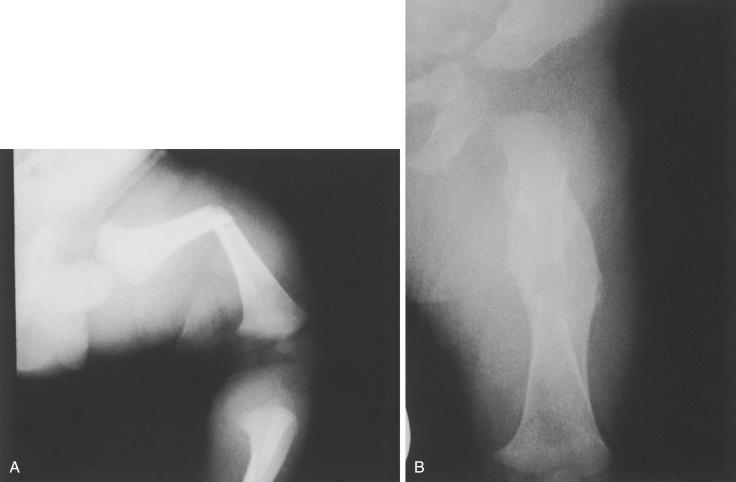
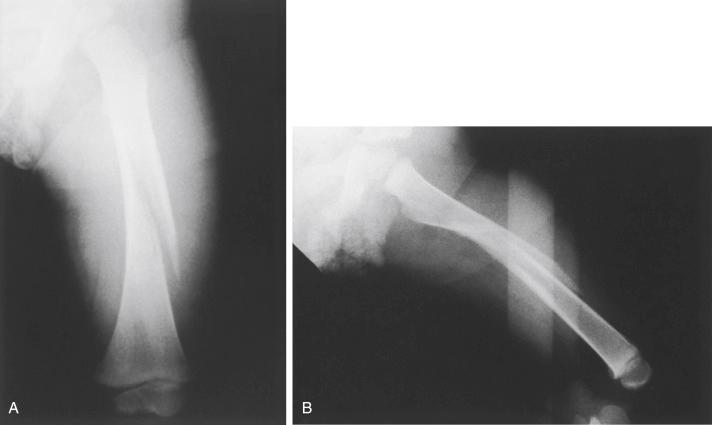
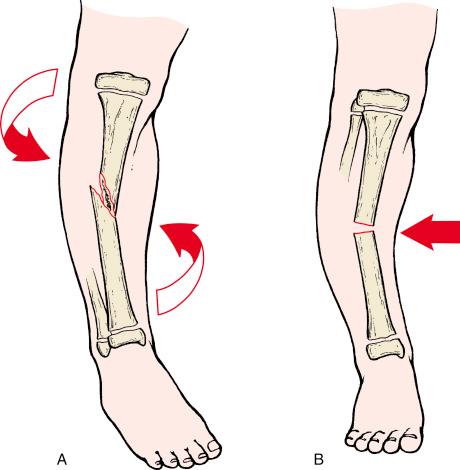
Femoral shaft fractures are seen in both accidental trauma and CPA; however, in children younger than 12 months, abuse accounts for 60% to 80% of these fractures. Abuse should be considered when a child younger than 2 years is seen with a femoral fracture. Fractures associated with CPA tend to occur in the distal femur or in combination with the distal femur more commonly. As many as 30% of femoral shaft fractures in children younger than 4 years may be the result of child abuse, and the most common cause of a femur fracture in the nonambulatory infant is CPA. Long spiral fractures of the femur are common in toddlers as a result of accidental trauma and should not be considered solely the result of abuse; several authors have recently shown that femoral shaft fracture patterns are unreliable in differentiating accidental from nonaccidental injury.
Humeral shaft fractures in young children have historically had a high association with child abuse and have not generally been reported as a result of accidental trauma. Worlock and colleagues found no cases of accidental humeral shaft fracture in children younger than 5 years; all the cases documented were the result of abuse. In contrast, all the supracondylar and condylar fractures of the distal end of the humerus in their series were the result of accidental trauma. However, more recent reports dispute these findings. In evaluating humeral fractures in children younger than 3 years, Strait and colleagues documented abuse in only 58% of humeral shaft fractures but found that 20% of the supracondylar fractures evaluated were associated with abuse. Abuse-related injuries in this study were significantly associated with an age younger than 15 months. Given these data, abuse should be considered in the differential diagnosis of all humeral fractures (including supracondylar fractures) in children younger than 15 months. Fractures of the radius and ulna, commonly seen in accidental trauma, are the least fractured long bones in child abuse.
One must be careful when assessing the cause of tibial shaft fractures in children of walking age. A nondisplaced spiral tibial shaft fracture (“toddler’s fracture”) is very common and is a result of accidental trauma. A toddler’s fracture typically occurs in the second or third years of life, and frequently the history of trauma is not always clear on initial examination. The parents may be unaware of the trauma because it occurred out of their sight. These facts all make differentiation from CPA very difficult. A metaanalysis, however, strongly recommends close evaluation of these injuries because of the high risk of inflicted trauma.
Diaphyseal fractures of the long bones are optimally treated with immobilization. Fractures of the shaft of the femur are best treated with a Pavlik harness in the young infant. If this is deemed insufficiently stable, application of an immediate spica cast is indicated. Some fractures of the shaft of the femur may be very unstable if the trauma has been significant enough to disrupt the periosteum. Therefore close observation with repeated radiographs is necessary until union of the fracture is complete, usually within 6 weeks. Hospitalization is necessary for completion of a social services investigation of the family and the circumstances of the injury.
Humeral shaft fractures should also be treated with immobilization, which is best accomplished with the application of a Velpeau bandage. Such fractures heal very quickly in an infant ( Fig. 20.6 ).
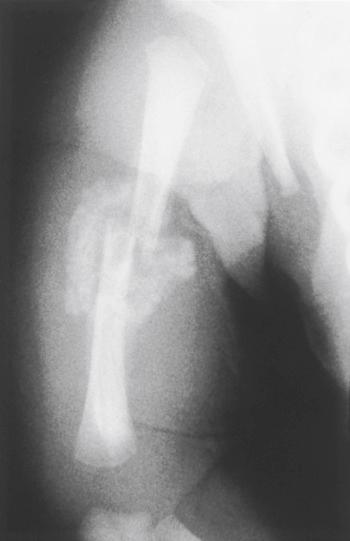
Become a Clinical Tree membership for Full access and enjoy Unlimited articles
If you are a member. Log in here